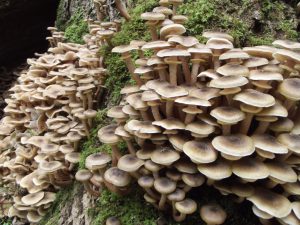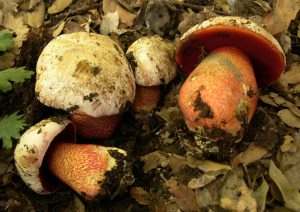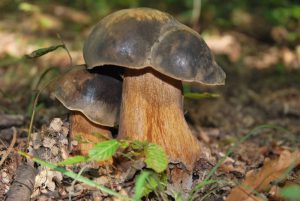Phone: 07964 569715 Email: geoffdann@hotmail.com
18/11/2016
Mushroom season 2016 is nearly over. Not quite over yet (I found some lovely Penny Buns today), but I am not expecting much new stuff to appear before the winter. It has not been a vintage year. Not the total wipeout of the second half of last autumn, but a lot of species either didn’t fruit at all this year or fruited very patchily and unenthusiastically. On the other hand, it was a memorable year for a few species, including a couple of the most spectacular: Fly Agarics and Honey Fungus.
The poor showing of most species has prompted more than one person to ask me whether it has anything to do with climate change, and what it is likely to mean for the future. 2016 is without doubt an important year in terms of climate change. We are on target for yet another record-breaking year in terms of average global temperatures, and there is something very scary going on in the Arctic right now. The deviation from historically-normal concentration of sea ice, which had been in steady decline for several years, has just fallen off a cliff. Some sort of tipping point has been reached, whereby the sea has gone from pretty much frozen in November, to pretty much not frozen.
Among other side-effects, this disappearance of the sea ice has led to the starvation of 80,000 reindeer. The reindeer usually feed on lichens beneath soft snow, but the changing climate has caused the snow to melt and then refreeze, covering their food in a thick layer of ice they cannot penetrate.
Fungi are less directly affected by climate; they are more at the mercy of weather, which is not the same thing. It is highly unlikely that the British Isles, which sits under a moving junction of several different climate systems, will experience a radical change – we are destined to continue getting random and unpredictable weather, even if on average it gets a bit warmer. We’ll still have extended spells of dry, wet, warm or cold weather, at unpredictable times of year, as the competing climate systems move about. It was the extended dry spell in late summer and early autumn that caused the problems this year – drainage ditches and ponds that are normally 1ft deep in water were empty until the end of October, and are only starting to fill up now.
A lot of fungi have extensive ranges that are determined by average temperatures. Their spores travel far and wide, but they are specialised in terms of at what temperature they can compete successfully with other fungi. They therefore tend to be common in the centre of their range, and rare at the edges, where the temperature doesn’t suit them so well. This is likely to be relevant to fungi foraging in the longer term, because quite a few species of interest to foragers are much more common further south in Europe. This includes quite a few boletes (mushrooms with tubes and pores rather than gills). British foragers are not accustomed to watching out for poisonous boletes because the only poisonous British boletes are so rare that most people will never find them. This is exactly the sort of thing that is likely to change, because at least five poisonous boletes are considerably more common further south and are likely to become more common in the British Isles as the climate warms up. They are the Devil’s Bolete (Rubroboletus satanus), the Bilious Bolete (Rubroboletus legaliae), the Ruddy Bolete (Rubroboletus rhodoxanthus), the Oldrose Bolete (Imperator rhodopurpureus) and the Brawny Bolete (Imperator torosus).
It is not all bad news though! Also in this category of likely-to-move-northwards is the best edible bolete of them all: the Dark Penny Bun (Boletus aereus). I’ve only ever seen this species on a handful of occasions, and always near the south coast. It is the only bolete tastier than a Penny Bun, and it is very welcome if it chooses to launch a serious invasion!
In other news, I have now been given the go-ahead by the Forestry Commission to run public sessions in Hemsted Forest next year, which means vouchers are available for Christmas presents. Details of this and other events in 2017, including my first dedicated coastal foraging sessions are here.
Finally, just a reminder that I am still selling signed copies of my book at the RRP of £20, including packing and postage.




